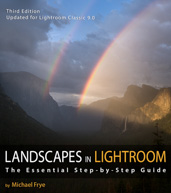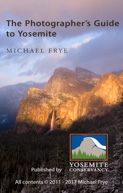by Michael Frye | Jun 15, 2009 | Yosemite Photo Conditions
 Yosemite weather has been unusually cool and wet for the past two or three weeks. It’s not uncommon to see afternoon thunderstorms in the summer, but it is highly unusual for it to rain almost every afternoon for close to three weeks this time of year. It makes me wonder how this moisture will affect the wildflowers. I have to believe it will help them, but since I’ve never seen this much rain before in early June it’s hard to say.
Yosemite weather has been unusually cool and wet for the past two or three weeks. It’s not uncommon to see afternoon thunderstorms in the summer, but it is highly unusual for it to rain almost every afternoon for close to three weeks this time of year. It makes me wonder how this moisture will affect the wildflowers. I have to believe it will help them, but since I’ve never seen this much rain before in early June it’s hard to say.
Summer is usually the peak wildflower season in the Yosemite high country. Although early bloomers like shooting stars appear in June, flowers are typically most abundant in July at elevations between 7000 and 9000 feet. Heavy snow the previous winter can push this peak back into August. This past winter brought average snowfall, so I’d usually expect an average amount of flowers with the peak in July, but the cool and wet weather might delay the bloom and maybe, just maybe, make the flowers more abundant than usual.
The photograph above was made near White Wolf in July of 2004 after slightly below average winter snowfall.
by Michael Frye | May 29, 2009 | Yosemite Photo Conditions
 Many people assume that once Memorial arrives Yosemite Valley will be overrun with tourists until after Labor Day. Sure, summer is the most crowded season in Yosemite. But there’s a little window between Memorial and the middle of June, the date most kids get out of school, when the valley is still relatively quiet. It’s actually a great time of year in the park. The roads to Tioga Pass and Glacier Point are usually open (as they are now), the waterfalls are still full—in fact often at their peak in early June—and the valley wildflowers are most abundant. The accompanying photo shows Cook’s Meadow with blooming cow parsnip in early June.
Many people assume that once Memorial arrives Yosemite Valley will be overrun with tourists until after Labor Day. Sure, summer is the most crowded season in Yosemite. But there’s a little window between Memorial and the middle of June, the date most kids get out of school, when the valley is still relatively quiet. It’s actually a great time of year in the park. The roads to Tioga Pass and Glacier Point are usually open (as they are now), the waterfalls are still full—in fact often at their peak in early June—and the valley wildflowers are most abundant. The accompanying photo shows Cook’s Meadow with blooming cow parsnip in early June.
by Michael Frye | May 22, 2009 | Announcements, Yosemite Photo Conditions
 Tioga Pass opened Wednesday, and we now have easy access to some of my favorite Yosemite locations: Tenaya Lake, Tuolumne Meadows, and Tioga Pass. I haven’t been up there yet, but usually when the pass first opens there’s still a lot of snow on the peaks near Tioga Pass, and ice on some of the lakes, making for some interesting photo opportunities. I made this image of melting ice and reflections near Gaylor Lakes (a short but steep hike from Tioga Pass) in 2006.
Tioga Pass opened Wednesday, and we now have easy access to some of my favorite Yosemite locations: Tenaya Lake, Tuolumne Meadows, and Tioga Pass. I haven’t been up there yet, but usually when the pass first opens there’s still a lot of snow on the peaks near Tioga Pass, and ice on some of the lakes, making for some interesting photo opportunities. I made this image of melting ice and reflections near Gaylor Lakes (a short but steep hike from Tioga Pass) in 2006.
This photograph is a good example of telephoto compression. Long lenses compress space and make objects look closer together than they really are. This is a good way to create abstract patterns, as in this image where the ice at the top of the frame is actually much farther from the camera than the ice at the bottom, but the visual impression is a flat, abstract design.
by Michael Frye | May 9, 2009 | Photography Tips, Yosemite Photo Conditions
 Last night I joined the throngs in Cook’s Meadow to photograph the lunar rainbow on Upper Yosemite Fall. There were at least 100 photographers around the meadow, and probably many more at the bridge below Lower Yosemite Fall. Like Horsetail Fall in February, lunar rainbows have become a photographic phenomenon. Until recently the most popular place was at Lower Yosemite Fall, but since Don Olson published specific times for seeing the “moonbow” from the Sentinel Bridge in Cook’s Meadow this spot has attracted lots of photographers. The big advantage is that it’s dry! At the bridge below Lower Yosemite Fall it’s impossible to keep mist off the front of the lens.
Last night I joined the throngs in Cook’s Meadow to photograph the lunar rainbow on Upper Yosemite Fall. There were at least 100 photographers around the meadow, and probably many more at the bridge below Lower Yosemite Fall. Like Horsetail Fall in February, lunar rainbows have become a photographic phenomenon. Until recently the most popular place was at Lower Yosemite Fall, but since Don Olson published specific times for seeing the “moonbow” from the Sentinel Bridge in Cook’s Meadow this spot has attracted lots of photographers. The big advantage is that it’s dry! At the bridge below Lower Yosemite Fall it’s impossible to keep mist off the front of the lens.
You can’t really see a lunar rainbow with the naked eye. Our eyes don’t render color very well in the dark, so at best you can see a bright arc and maybe a hint of color. But the color is there, and film or digital sensors capture it well. One of the reasons that more people haven’t photographed lunar rainbows from Cook’s Meadow in the past is that you can’t really see it from there. With film you’d just have to guess about the position and wait to find out whether you were right. With digital sensors it’s easy to just take a photo and see the position of the rainbow.
Last night the moon was bright enough that I could see the rainbow fairly well. Along with everyone else I watched it move down the fall as the moon rose. When the rainbow fell too low, most people packed up (it was 11:30 p.m. after all), but I followed the moon westward and saw an even more vivid rainbow from near the Yosemite Chapel. This photograph was made from that spot. Rainbows form a circle around a spot opposite the light source—sun or moon. Lunar rainbows can be seen on any waterfall that gets moonlight if you position yourself properly. In fact I photographed a lunar rainbow on Castle Geyser in Yellowstone many years ago. Maybe I’ll put that image in another post.
Long exposures with digital cameras can create lots of noise, but newer models handle this pretty well. You’re usually better off making a long exposure at a low ISO than a shorter exposure with a higher ISO. But with lunar rainbows you don’t want to make the exposure too long or the bands of color will blend together. I used a six-minute exposure at f/4 and 100 ISO for the image above. Trying to lighten a dark image will exaggerate noise, so it’s best to make the photograph as light as possible without overexposing it. Don’t rely on just how it looks on your LCD screen. Since it’s dark, the screen will look bright even if the image is underexposed. Use your histogram.
Having said that, a nighttime photograph shouldn’t be too bright. You don’t want it to look like it was taken under midday sunlight. I actually darkened this image—especially the sky—in software to give it more of a nighttime feeling.
by Michael Frye | May 5, 2009 | Yosemite Photo Conditions
 The dogwoods in Yosemite Valley are nearing their photographic peak. Although some are still in that green stage, most are now in full bloom, yet haven’t leafed out yet. I made the photo above last Friday near the Ahwahnee Hotel.
The dogwoods in Yosemite Valley are nearing their photographic peak. Although some are still in that green stage, most are now in full bloom, yet haven’t leafed out yet. I made the photo above last Friday near the Ahwahnee Hotel.
The waterfalls got a big boost from Friday’s night’s rain. Although the predicted minor flooding never materialized, the falls and meadows are full of water. In short, it’s a great time for photography in the Valley.
by Michael Frye | Apr 24, 2009 | Yosemite Photo Conditions
 The dogwoods in Yosemite Valley haven’t fully bloomed yet, but they’re progressing. Many are now in their “green” stage, where they sport greenish-yellow blossoms. These will change to white soon, although I don’t know exactly how soon. Cooler weather has descended on the Sierra and is expected to linger through next week, so that could slow things down a bit, but I would still expect most of the valley dogwoods to be in full bloom a week from now.
The dogwoods in Yosemite Valley haven’t fully bloomed yet, but they’re progressing. Many are now in their “green” stage, where they sport greenish-yellow blossoms. These will change to white soon, although I don’t know exactly how soon. Cooler weather has descended on the Sierra and is expected to linger through next week, so that could slow things down a bit, but I would still expect most of the valley dogwoods to be in full bloom a week from now.
 Yosemite weather has been unusually cool and wet for the past two or three weeks. It’s not uncommon to see afternoon thunderstorms in the summer, but it is highly unusual for it to rain almost every afternoon for close to three weeks this time of year. It makes me wonder how this moisture will affect the wildflowers. I have to believe it will help them, but since I’ve never seen this much rain before in early June it’s hard to say.
Yosemite weather has been unusually cool and wet for the past two or three weeks. It’s not uncommon to see afternoon thunderstorms in the summer, but it is highly unusual for it to rain almost every afternoon for close to three weeks this time of year. It makes me wonder how this moisture will affect the wildflowers. I have to believe it will help them, but since I’ve never seen this much rain before in early June it’s hard to say.












